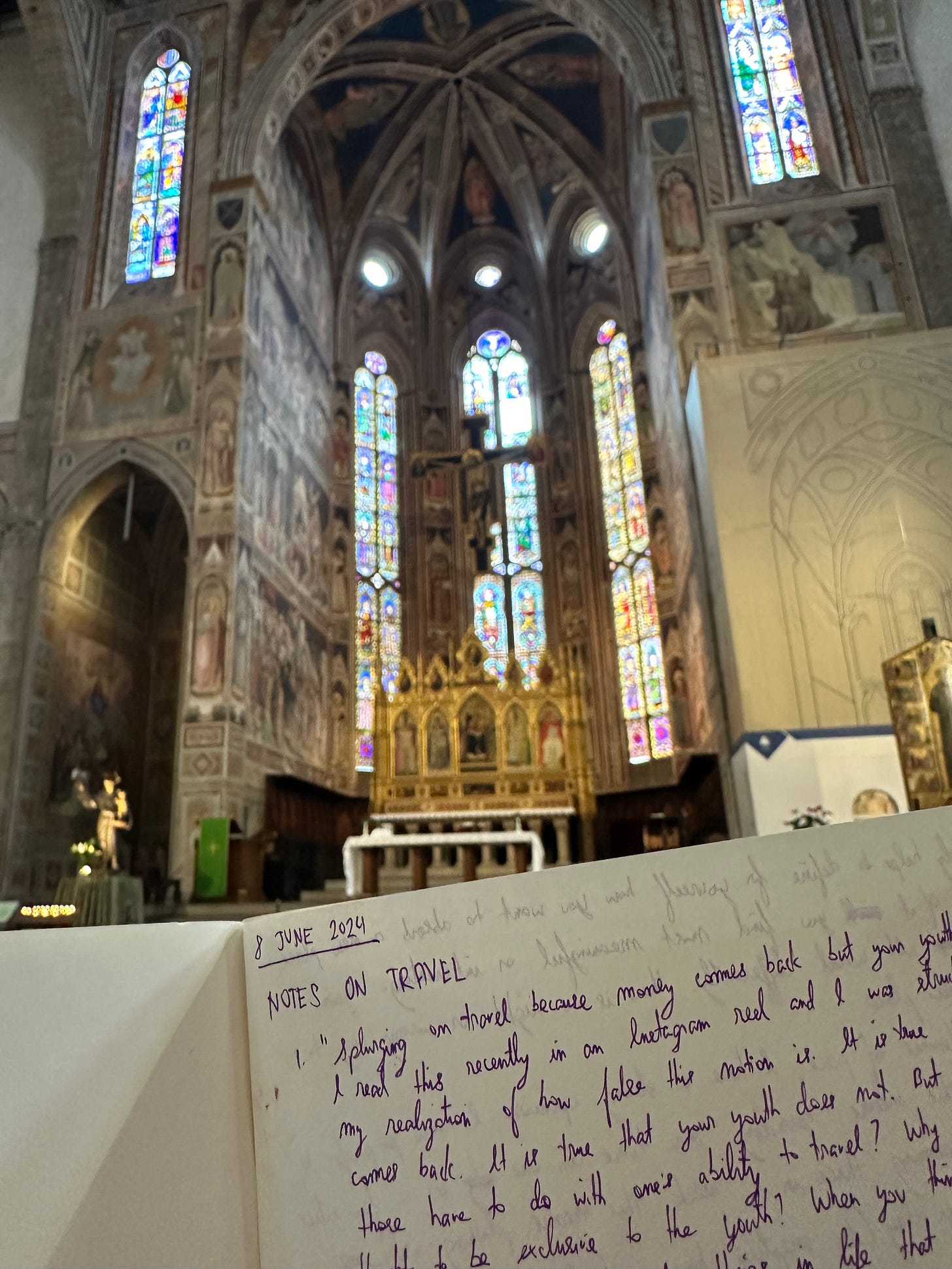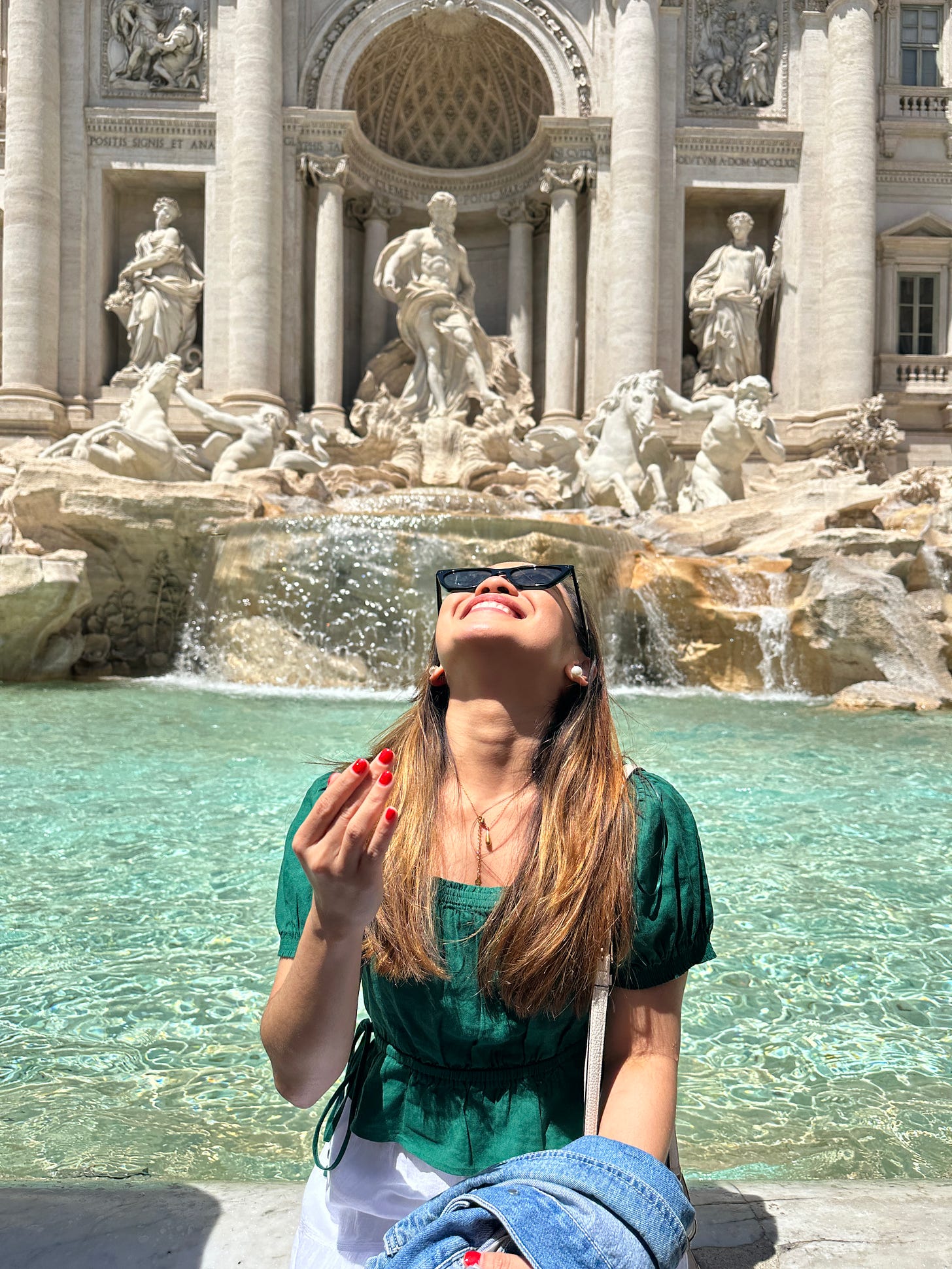As hard as it is to be a (supposed) full-fledged adult, I think one of its greatest pleasures and sources of pride is gaining the wherewithal to travel — to explore the world the way we want to.
Maybe it’s a natural consequence of using hard-earned money to book a flight, but what I’ve come to appreciate even more over the years is how I’ve become more conscious of how I want to travel. That is, how can I make the most out of these beautiful, finite experiences? How can I make my trips more seamless? And how do I feel about the culture around traveling?
As of posting, I’ve just gotten back from my three-week Europe trip, my longest Europe trip yet. Hit with all these realizations about travel, I’ve decided to compile them in this newsletter. This will be a running post, which means I’ll keep adding my insights as they calcify in my head. I wouldn’t be surprised if I changed my opinion at one point. So check back whenever you can, or just subscribe below; I’ll update in future newsletters if I’ve added something to this post!

“Splurge on travel now”, urged the Instagram reel. “Money comes back, but your youth won’t.” Hmm. I mean it’s not the first time I read this piece of advice or some version of it on the internet. Reading it now, I’m struck by how strange and questionable the logic feels. But I remember that urgency. It wasn’t too long ago when I was twenty-something, honestly convinced that this was the absolute best time for me to see the world. I mean I have purchasing power! I’m unattached, young, and vital! I can clock in north of 20,000 steps in a day and still have energy for a few rounds at the club! So I understand why it’s tempting to assume travel is best done while you’re young. And perhaps for certain experiences like climbing Mt. Pulag or whatever, it’s best to try them while your back isn’t aching or your knees aren’t crackling yet. But what I’ve come to realize and often try to remind myself nowadays is this: there’s no deadline for traveling. How could there be when places don’t expire? It takes a very, very long time for countries and cultures to change. I can visit Japan in a year or three or five. I can still see the Swiss Alps in mid-life. I can catch the hot air balloons in Cappadocia, my Crow’s Feet revealing themselves as I watch the balloons float during sunrise. I’ve seen white-haired couples lugging their baggage in train stations — an endearing reminder of our lifelong capability to travel. Once, on a flight, the retired immigrant sitting beside me enumerated to me his favorite adventures around the world. These moments remind me of a quote from the book Tomorrow, and Tomorrow, and Tomorrow: “Life is very long — unless it is not.” Life, if we’re lucky, is very long. We have time to see the world. Growing old does not preclude travel. Even when life might demand for a few years that we channel our resources and tend to more crucial obligations at home, my wanderlust will simply be waiting. As I grow older, maybe I’ll simply have to slow down as I explore the world. But might that not simply make the experience better? (More on this in #4)
A travel best practice so far: doing away with my wallet. Instead, I use a bag with zipper-secured pockets inside and store my money there (I spread it around if there’s more than one compartment — a tip from my mom!). This makes it more difficult for pickpockets to steal from me. Also, though it might feel less organized, I actually find it more convenient. Instead of taking out and opening my wallet, I only have to open my bag to get cash. (I put my card in my phone case, which feels more secure since I’m always holding onto my phone when I travel.)
(1) Food, (2) Parks & plazas, (3) Museums, (4) Palaces, (5) Nightlife. This was my answer when someone asked me what I’d like to see or do when I visit his city.
I didn’t think much of my response at first, but I think this piece of self-awareness has served me more than I realize. It’s as if I’d always known this subconsciously, and now that I’ve articulated them, it’s become so much easier to make decisions when I travel. And there are a lot of decisions to make when you go to a new place. What should you see and try and do? With this broad definition of my preferences, I really think it has lessened my decision-making fatigue. I know I’d be more than willing to go out of my way to try the best food in a place. I would rather stroll around a park or plaza than a museum. I’d rather pay to see an art museum than a palace. We all travel under constraints. If not financial, then temporal or physical. Heuristics help us in the face of the I-Must-Do-And-See-Everything-While-I’m-Here-Else-I-Waste-My-Trip dilemma. And it is also this point that I think makes this ranking exercise even more valuable: It helps you stay true to what matters most to you when you travel. How do you want to absorb and enjoy a place? What aspects of a city will help you appreciate it more? When I went to Salzburg, the city of Mozart, the only Mozart-related thing I did was eat his balls. (Mozartkugel, the chocolate balls named after him! What were you thinking?) I didn’t visit his museum or house even if they were deemed a must-see tourist spot, a stone’s throw away, and I technically could have made time. What did I do instead? I ate. I sat in the al fresco area of a restaurant in the middle of a plaza, ordered Prosecco, and watched the locals.
There is no one way to travel. HOWEVER, in terms of pace, I have a strong opinion. In 2016, I went to Europe with my sister and cousin where we went to three countries in ten days (including flights). #Eurothon2016, we called it. While I’m sure I had fun, I remember most of it as a blur. I no longer want to travel that way. I now prefer slow travel. This means staying longer in one or two cities rather than cramming three in a week. This means plotting only one major attraction per day. (My exception here is to plot two attractions that vary in nature or degree of stimulation. One day in Florence, for example, I did the Uffizi gallery in the morning then climbed Brunelleschi’s dome in the afternoon.) This means meandering walks, discovering boutiques and alleys steeped in local color. This means: Buskers at sunset. Lazing on a park bench. Lounging in a cafe. Watching a street artist turn a blank canvas into a full-color painting. Capturing photos with your eyes. Roaming around with a stranger. Revisiting a spot because you loved it that much. Slow travel is where you allow yourself to register your awe and bliss and delight and think, per Kurt Vonnegut, “If this isn't nice, I don't know what is.”
Many of my most magical travel moments happened during the blank spaces of my trips, when I fought the urge to fill my day and keep walking for the sake of. Also, I find trips to be much more enjoyable when I have fewer expectations, which is to say: a less curated itinerary. If you want a plot twist, sometimes it’s just a matter of making space for surprise.
I decided to do a solo trip to Florence as an Artist Date. Just me, taking in all its history, art, and culture. But, thinking I was coming during peak season, I ended up pre-booking too many attractions. And since I’d already paid for them, I pushed myself to see as much as I could. It was exhausting. So here’s another battle cry for doing less: When you’re tired, you don’t notice things — much less absorb them.
I think we miss out on traveling not by failing to see everything, but by failing to be all there.
How much should you try to learn when you’re in a new place? I found myself asking this as I debated paying for yet another audio guide for a museum. I’ve taken many guided tours in my life, hosted by highly engaged and perfectly fluent tour guides. I listen intently. I ask questions. When a nugget of information strikes me, I tell myself to take a mental note, but it rarely sticks. So what’s the point of insisting on learning so much? Why shell out more money for cultural and historical tidbits you’ll probably forget the next day? I think that, like school, the point of learning as you travel isn’t about retention. It’s essentially about cultivating a curious, open, appreciative, and creative mind. I suspect these new bits of information impact us in the same mystical way that reading does. Per Ralph Waldo Emerson: “I cannot remember the books I've read any more than the meals I have eaten; even so, they have made me.”
The quintessential train ride: A seat by the window. Pristine terrains dotted with rural villages speeding by, capped by a blue, cloud-streaked sky. On your hands is a paperback — bright, natural light illuminating every page. This is how I envisioned myself in the many trains I knew I’d be taking across Italy: reading. But come those train rides, I couldn’t bring myself to do it. Gazing outside the window I thought about how, on a normal day, my eyes are almost always glued to a screen. How, living in Metro Manila, I hardly see or have access to sceneries so vast and verdant. And I thought: I can read at home. For now, I’m here.




As we travel more, slow travel is really the best way to go. I am never worried that I don't get to finish everything; I know I will come back. When we rush things, we don't leave time to experience them. Great piece.